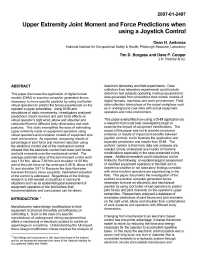Mining Publication: Upper Extremity Joint Moment and Force Predictions When Using a Joystick Control
Original creation date: June 2007
This paper discusses the application of digital human models (DHM) to examine computer-generated forces necessary to move specific joysticks by using roof bolter virtual operators to predict the forces experienced on the operator's upper extremities. Using DHM and simulations of static movements, investigators analyzed predictions of joint moment and joint force effects on virtual operator's right wrist, elbow and shoulder and compared them to different body dimensions and work postures. This study exemplifies the ease of estimating upper extremity loads on equipment operators using virtual operators and computer models of equipment and work environment. As expected, comparing results of percentage of joint force and moment reduction using the electronic control and of the mechanical control showed that the electronic control had lower joint forces and joint moments over the mechanical control. The average predicted value of the joint moment on the wrist was 1.84 Nm, elbow 7.85 Nm and shoulder 14.55 Nm and of the joint force on the wrist was 5.06 N, elbow 4.56 N, and shoulder 3.67 N. Because the data illustrates low-level forces to move a joystick, inadvertent actuation of the control is addressed. Regardless of the findings, research is still needed on joysticks in real-world situations such as an epidemiological assessment of equipment operators in the field before final recommendations and conclusions can be drawn.
Authors: DH Ambrose, TD Burgess, DP Cooper
Conference Paper - June 2007
NIOSHTIC2 Number: 20032157
2007 Digital Human Modeling for Design and Engineering Conference and Exhibition, Seattle, Washington, June 12-14, 2007. Technical paper 2007-01-2497, Warrendale, PA: Society of Automotive Engineers, 2007 Jun; :1-7
See Also
- Computer Simulations Help Determine Safe Vertical Boom Speeds for Roof Bolting in Underground Coal Mines
- Development and Application of Reservoir Models and Artificial Neural Networks for Optimizing Ventilation Air Requirements in Development Mining of Coal Seams
- Machine Injury Prediction by Simulation Using Human Models
- Mining Roof Bolting Machine Safety: A Study of the Drill Boom Vertical Velocity
- Modeling and Prediction of Ventilation Methane Emissions of U.S. Longwall Mines Using Supervised Artificial Neural Networks
- Modernization and Further Development of the NIOSH Mine Emergency Response Training System (MERITS), Phase 1
- SPONCOM - A Computer Program for the Prediction of the Spontaneous Combustion Potential of an Underground Coal Mine
- Technology News 549 - MFIRE 3.0 - NIOSH Brings MFIRE into 21st Century
- Verification and Validation of Roof Bolter Simulation Models for Studying Events Between a Machine and its Operator
- Visual feedback system to reduce errors while operating roof bolting machines
- Page last reviewed: 9/21/2012
- Page last updated: 9/21/2012
- Content source: National Institute for Occupational Safety and Health, Mining Program


 ShareCompartir
ShareCompartir
